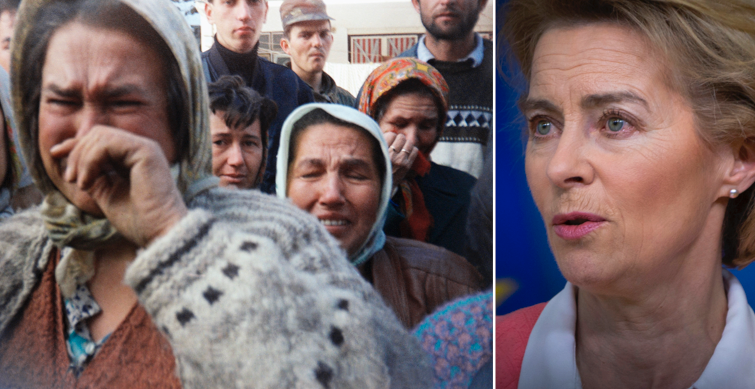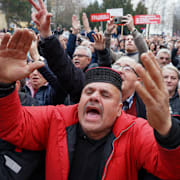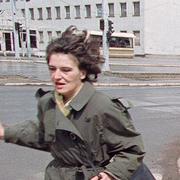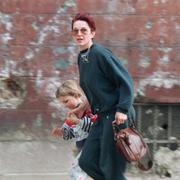
Digital ceremoni för offren: ”Fortfarande ett öppet sår”
En digital minnesceremoni har hållits för offren i folkmordet i Srebrenica under Bosnienkriget 1995.
Statsminister Stefan Löfven (S) deltog via videolänk tillsammans med bland andra Frankrikes president Emmanuel Macron, Europeiska kommissionens ordförande Ursula von der Leyen och Storbritanniens premiärminister Boris Johnson.
– Det här får aldrig hända igen. Ett erkännande av offrens och deras familjers lidande är väsentligt för att gå vidare, sa Löfven i sitt minnestal.
Ursula von der Leyen sa i sitt tal att Srebrenica efter ett kvarts sekel fortfarande är ”ett öppet sår i Europas samvete”.
Omkring 8 000 män och pojkar mördades av bosnienserbiska styrkor trots att Srebrenica skulle stå under FN:s beskydd.
bakgrund
Folkmordet i Srebrenica
Wikipedia (en)
The Srebrenica massacre, also known as the Srebrenica genocide (Bosnian: Masakr u Srebrenici; Genocid u Srebrenici), was the July 1995 genocide of more than 8,000 Bosniaks, mainly men and boys, in and around the town of Srebrenica during the Bosnian War.
The killings were perpetrated by units of the Bosnian Serb Army of Republika Srpska (VRS) under the command of Ratko Mladić. The Scorpions, a paramilitary unit from Serbia, who had been part of the Serbian Interior Ministry until 1991, also participated in the massacre. In April 1993 the United Nations (UN) had declared the besieged enclave of Srebrenica—in the Drina Valley of northeastern Bosnia—a "safe area" under UN protection. However, the UN failed to both demilitarize the Army of the Republic of Bosnia and Herzegovina (ARBiH) within Srebrenica and force the withdrawal of the VRS surrounding Srebrenica. UNPROFOR's 370 Dutchbat soldiers in Srebrenica did not prevent the town's capture by the VRS—nor the subsequent massacre.Throughout the first year of the war, Srebrenica saw heavy fighting and the town at the center of the municipality experienced Serb military and artillery assaults, accompanied by the ethnic cleansing of Bosniak civilians in towns and villages that were in the hands of Serb forces. From late 1992 to January 1993, Bosniak forces under the command of Naser Orić launched military incursions into Serb villages around Srebrenica that were held under Serb control. These operations resulted in the murders of Serb civilians as well as soldiers, though the number of casualties have been subjects of controversy. From the Serbian perspective, these casualties are sometimes presented as the motivation behind the 1995 massacre due to a desire for revenge. Attempts to justify the genocide on the basis of revenge for prior crimes committed against Serbs have been categorically rejected and condemned by the ICTY and UN.
In 2004, in a unanimous ruling on the case of Prosecutor v. Krstić, the Appeals Chamber of the International Criminal Tribunal for the former Yugoslavia (ICTY), located in The Hague, ruled that the massacre of the enclave's male inhabitants constituted genocide, a crime under international law. The ruling was also upheld by the International Court of Justice (ICJ) in 2007. The forcible transfer and abuse of between 25,000 and 30,000 Bosniak women, children and elderly which accompanied the massacre was found to constitute genocide, when accompanied with the killings and separation of the men.In 2005, Kofi Annan, then Secretary-General of the United Nations described the mass murder as the worst crime on European soil since the Second World War, and in a message to the tenth anniversary commemoration of the massacre, he wrote that, while blame lay "first and foremost with those who planned and carried out the massacre and those who assisted and harboured them", the UN had "made serious errors of judgement, rooted in a philosophy of impartiality", describing Srebrenica as a tragedy that would haunt the history of the UN forever.In 2006, in the Bosnian Genocide case held before the International Court of Justice, Serbia and Montenegro was cleared of direct responsibility for, or complicity in, the massacre, but was found responsible for not doing enough to prevent the genocide and not prosecuting those responsible, in breach of the Genocide Convention. The Preliminary List of People Missing or Killed in Srebrenica compiled by the Bosnian Federal Commission of Missing Persons contains 8,373 names. As of July 2012, 6,838 genocide victims have been identified through DNA analysis of body parts recovered from mass graves; as of July 2013, 6,066 victims have been buried at the Memorial Centre of Potočari.In April 2013, Serbian President Tomislav Nikolić officially apologised for the massacre, although he stopped short of calling it genocide. In 2013, 2014, and again in 2019, the Dutch state was found liable for only 10% in its own supreme court and in the Hague district court of failing to prevent more than 300 of the deaths.On 8 July 2015, Russia, at the request of the Republika Srpska and Serbia, vetoed a UN resolution condemning the Srebrenica massacre as genocide. Serbia called the resolution "anti-Serb", while European and U.S. governments affirmed that the crimes were genocide. On 9 July 2015, both the European Parliament (EP) and the U.S. Congress adopted resolutions reaffirming the description of the crime as genocide.On 22 November 2017, Ratko Mladić was convicted of various crimes at the United Nations tribunal, including genocide for his role at Srebrenica. He was sentenced to life imprisonment. As of May 2020, the judgement is pending appeal.
Omni är politiskt obundna och oberoende. Vi strävar efter att ge fler perspektiv på nyheterna. Har du frågor eller synpunkter kring vår rapportering? Kontakta redaktionen



